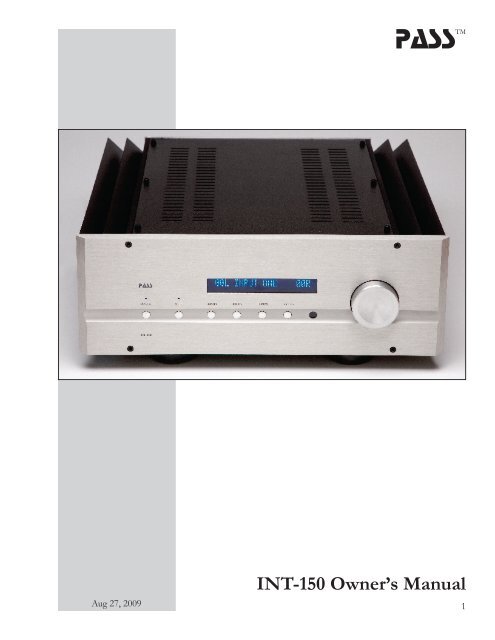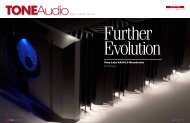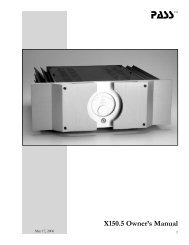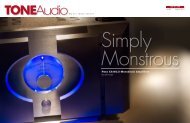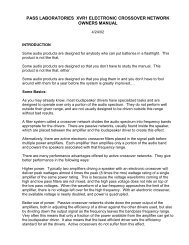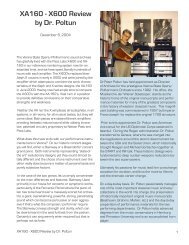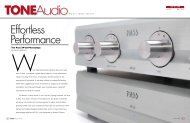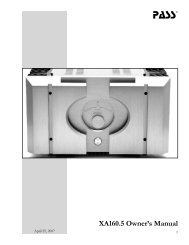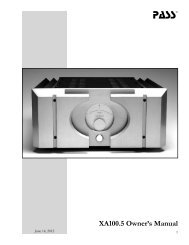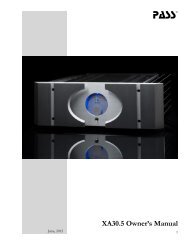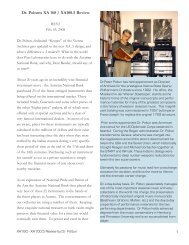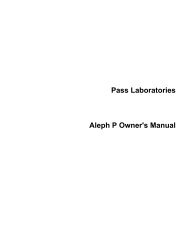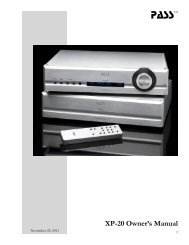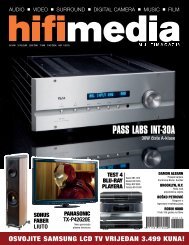INT-150 - Pass Labs
INT-150 - Pass Labs
INT-150 - Pass Labs
You also want an ePaper? Increase the reach of your titles
YUMPU automatically turns print PDFs into web optimized ePapers that Google loves.
passTM<strong>INT</strong>-<strong>150</strong> Aug 27, Owners 2009Manual<strong>INT</strong>-<strong>150</strong> Owner’s Manual1
WARNINGPlease keep these instructions and heed all warnings.Use product only for intended function.For your protection please read the following:Water and moisture: Electrical devices should not be used near water(as per example, near a bathtub, washbasin, kitchen sink, laundry tub, wetbasement or swimming pool. ) Care should be taken such that objects donot have the opportunity to fall, and that liquid is never spilled onto or intothe device enclosure through openings.Power Sources: An electrical device must be connected to a mains powersource in strict accordance with the supplied product owners manual.Please verify that the AC mains voltage specified in the product manualmatch those requirements indicated on the unit and the AC voltageprovided to your location by the power company. Unplug this apparatusduring lightening storms or when unused for long periods of time. Tocompletely disconnect this apparatus from mains power, disconnect thepower cord from the AC receptacle. The equipment power switch does notprovide adequate protection to be considered a service disconnect.Grounding: Adequate precautions should be taken so that the groundingprovisions built into an electrical product are never defeated.Power Cords: <strong>Pass</strong> <strong>Labs</strong> provides a power supply cord that meets alllegislated requirements for the market in which the product was originallysold. If you choose to substitute an after-market product we urge youto choose a polarized cord that is fully safety rated by the necessary localauthority. Under no circumstances defeat the safety purpose of anypolarized plugs. If the supplied power cord does not fit your power outlet;consult a qualified electrician, never modify the plug.Power Cord Protection: Power supply cords should be routed so thatthey are not likely to be walked on, abraded, or pinched by items placedon or against them, paying particular attention to cords where they enterplugs or exit from a device. Never under any circumstance insert a cut ordamaged power cord into a mains power socket.Power and Signal: Cables should never be connected / disconnectedwith equipment powered up. Failure to heed this warning may cause injury,damage or destroy equipment.Ventilation: Power-amplifiers run hot, but you should be able to placeyour hands on them without discomfort. You must allow for this heatin installation, by providing for free air circulation around the product.Electronics should not be subjected to sources of excessive radiant heat.Excessive heat can shorten the life of the product and may cause theelectronics to self protect and shut down. Never block any ventilationopenings. Allow at least 6 inches of clearance around these products forproper ventilation.<strong>INT</strong>-<strong>150</strong> Owners Manual2
Crush and Tip Hazard: When moving or placing these products usecaution to avoid injury from tip-over or fall. Make sure that any stand,cart, table, bracket or tripod used to support this product is weight ratedsufficient to the task.Servicing: To reduce the risk of fire, electrical shock or other injuries,the user should not attempt to service the device beyond that whichis described in the operating instructions. All other servicing must bereferred to qualified service personnel.For Units With Externally Accessible Fuse Receptacle: Unplug thedevice from all sources of power before changing or inspecting anyfuse. Replace fuse with one of same physical size, type and rating as thatspecified by the manufacture for that product.<strong>Pass</strong> LaboratoriesPO Box 21924449 Foresthill RdForesthill, CA 95631 USAwww.passlabs.comservice@passlabas.comtel: (530) 367 3690fax: (530) 367 2193“<strong>Pass</strong>”, “pass”, “<strong>Pass</strong> <strong>Labs</strong>”, “<strong>Pass</strong> Laboratories”, Supersymmetery”,“Aleph”, and “Zen” and are all registered trademarks of <strong>Pass</strong>Laboratories, Inc., and all rights thereto are protected by law.<strong>INT</strong>-<strong>150</strong> Owners Manual3
IntroductionNelson <strong>Pass</strong> has been designing audio electronics professionally sinceabout 1971, first with ESS (remember Heil Air Motion transformers?), andthen forming a new company, Threshold in 1975. Threshold pioneeredthe design of high power Class A power amplifiers and later, high poweramplifiers using only local feedback (the Stasis series).<strong>Pass</strong> sold Threshold and created <strong>Pass</strong> Laboratories in 1991, where heconcentrated first on elevating single-ended Class A power amplifiers tonew power levels and performance, the Aleph series.Along the way he found the time to design highly successful lines ofamplifiers for such companies as Adcom and Nakamichi, and hascontributed approximately 60 designs (so far) to the public “Do-It-Yourself ” audio hobbyist community.Over the years, Nelson <strong>Pass</strong> has made power, simplicity, and performancehis design signatures. The hardware tends to run heavy and hot, but elicitshigh performance and reliability from simple circuits with little or nonegative feedback.In 1998 <strong>Pass</strong> <strong>Labs</strong> released the X series of audio power amplifiers, basedon the trademarked “SuperSymmetric” topology (U.S. Patent #5,376,899),which elicits high power and performance from simple circuits withminimal feedback.The first X amplifier, the X1000 was intended as the premier example ofthe power of this principle, delivering 1000 watts rms into 8 ohms at lowdistortion. By itself of course, this is no miracle, but you have to considerthat products with comparable performance have complicated circuitswith as many as nine consecutive gain stages and lots and lots of negativefeedback. The X1000 had only two stages and used only minimal localfeedback.The difference was the unique balanced circuit topology in which circuiterrors are replicated at both output terminals so as to cancel and disappearacross the loudspeaker terminals. The high quality of the sound reflectsboth the low distortion and simplicity of the gain path.The SuperSymmetric circuit consists of two identical matched circuitsarranged like the wings of a butterfly, showing symmetry from left to right,and operating balanced to the loudspeaker. The amplified signal appearswith opposing phase and equal potential across the loudspeaker. Most ofthe distortion and noise appears in phase across the loudspeaker, and is notseen.We start with simple FET circuits already having low distortion andnoise, and arrange them in two symmetrical halves. The two halves ofthe amplifier channel are closely matched, eliminating a large portion ofdistortion and noise without feedback. A small amount of feedback is alsoapplied, not so much for the purpose of reducing distortion but to make<strong>INT</strong>-<strong>150</strong> Owners Manual4
the distortion as identical as possible on both polarities of the balancedoutput.It is easier to make distortions in the two halves more identical than toremove them with feedback, and this is the operating principle of Xamplifiers.Since the X1000, <strong>Pass</strong> <strong>Labs</strong> products have continuously evolved towardhigher performance. The Class AB “X” series was joined by the ClassA “XA” amplifiers. Subsequent improvements to the Class AB “X”amplifiers resulted in the “X.5” products, and their phenomenal success hasled to the Class A “XA.5” series.As always the goal has been the best musical and objective performancepossible with minimal parts in the signal path and minimal feedback. Thisprocess is not completely quantified, and many of the improvements arethe result of trial and error and extensive listening.Measurement of performance is important to us, and we feel that welldesignedproduct sounds good and measures good. Apparently it ispossible to make an amplifier which measures well but which does notplease the ears, and so we let our ears be the final judge.The X amplifiers deliver more output power per dollar, and the XAamplifiers have a better subjective performance. All of the amplifiers driveknown loudspeaker loads without misbehaving, and all are unconditionallystable into low impedance and reactive loads.All the usual performance metrics - power, distortion, noise, inputimpedance, damping factor and bandwidth have all been improved in thislatest generation. The power supplies are larger, with fast rectifiers gatingto larger capacitor banks. The increases in AC line noise worldwide havebeen addressed with heavier EMI filtering and dramatically quieter powertransformers. In addition, through improved biasing regulation, the circuitsgive much more consistent performance under varying AC line voltagesand over a variety of ambient temperatures.All this is very nice, but only if it improves your listening experience. Welisten very carefully and critically to our amplifiers with a wide variety ofassociated equipment and we take our time with it. Musical performance ismost important, and is the basis of our success over the years.It’s true that we also value the other things. The design and manufacturingdecisions have to balance subjective performance against reliability, cost,specs, and ego (in approximately that order). That is why we make morethan one amplifier, but all are built with the same commitment to quality.The <strong>Pass</strong> Laboratories <strong>INT</strong>-<strong>150</strong> Integrated Amplifier was designedspecifically to bridge the gap between so called high-end audiophile productand the need for a simple “no nonsense”, convenient, user-friendly, high<strong>INT</strong>-<strong>150</strong> Owners Manual5
satisfaction audio product. From a measured and subjective viewpoint thisis an outstanding product, we trust you will sit back and listen with a biggrin on your face.If you have purchased this amplifier, we thank you for your confidence,and hope that you enjoy it for many years. If you need product service,have any questions or comments, or if we can help you with your audiosystem, please don’t hesitate to contact us.SetupX topology amplifiers run at about the same power as their output rating,and a large part of that energy gets dissipated across the heat sinks. Expectthe heat sinks on the side of the amplifier run hot to the touch – about25 to 30 degrees C. above ambient, so you can expect 50 to 55 degrees C.temperatures on the heat sinks. It is very important to the long life of theamplifier that they get good ventilation.You can put this amplifier anywhere you wish, but it must have goodventilation to properly cool. Do not place this product in enclosed cabinetsor small closets without means for air to circulate freely. Stacking thesepower amplifiers directly upon each other is not recommended for thesame reason. You should have a minimum of about 6 inches clearance tothe top and sides for adequate air circulation. Never block any ventilationopenings in the chassis. Never expose this product or it’s remote controlto excessive heat sources, such as domestic heaters or open fires. Keep allelectrical devices away from liquids, and liquids away from electrical devices.When not actually intending to play music the amplifier should be leftin standby mode from the front panel switch, where it draws only a fewwatts of bias on the output stage. If you wish to reduce the power drawto 0, you can shut the amplifier off via the rear panel switch, however werecommend that for minimum noise at the loudspeaker this switch shouldbe toggled in stand-by mode, only. If you are not going to use this productfor an extended period of time or if you are expecting an atmosphericelectrical disturbance (lightening storm) un-plug it. We have provided astandard IEC polarized power cord that fits into the standard 15 amp IECreceptacle at the rear of the amplifier chassis.Given the character of these amplifiers current draw, we generally do notrecommend active line conditioners, although they are unlikely to damagethe amplifier. Save your line conditioner for the low level components, likeyour cd player.This amplifier is equipped for operation with an earth ground provided bythe users AC outlet. Never defeat this ground connection or the polarizedplug of the power cord. The signal ground of this amplifier is connectedto earth through a power thermistor, which provides a safety ground butprovides isolation from system ground loops. Should your audio systemhave a device that requires an additional signal ground you will find thatground on the rear of the <strong>INT</strong>-<strong>150</strong> at the white binding post which ismarked “Signal Gnd”.<strong>INT</strong>-<strong>150</strong> Owners Manual6
1) Vacuum Florescent display ; shows operational status.2) Mute, indicator (Blue LED)3) Stand-by Power on, indicator (Blue LED)4) Stand-by Power on, momentary push button (on / off)5) Mute, momentary push-button (on / off)6) Input selection buttons (inputs 1-4)7) IR remote, receiver window8) Volume controlA) Pre-amplifier inputs (1&2 XLR/RCA , 3&4 RCA)B) Pre-amplifier outputs (XLR OR RCA)C) Right Channel speaker connectorD) Signal ground connectorE) IEC 520 AC power inlet moduleF) Main Power switch (not a safety disconnect)G) Fuse holderH) Left Channel Speaker connector<strong>INT</strong>-<strong>150</strong> Owners Manual7
For maximum safety we suggest that the power cord should be the lastcable installed on your power-amplifier.You may, if you wish, substitute a 15-amp aftermarket power cord for theone we have supplied. Only use polarized power cords, which meet alllocal safety standards and carry acceptance marks from the local regulatoryauthority. The power cord should be attached to the amplifier prior toplugging into house power. Always place the rear-mounted switch in theoff (down) position before plugging in this amplifier.The amplifier’s voltage and current rating are indicated on the rear panel.It will be indicated as either 100 volts, 120 volts, 220 volts, 230 volts or240 volts. The smaller <strong>Pass</strong> Laboratories power amplifiers, preampsand integrated amplifiers use a slow-blow 3AG (equivalent to 313 in ECmarkets) type fuse. The required value of the fuse will be indicated onthe amplifier. The frequency rating of the AC line source is 50 to 60Hz. Please verify that the amplifiers indicated voltage requirements areconsistent with the supplied voltage and current at your location.On the rear panel you will find both RCA and XLR type input connectionsfor single-ended or balanced inputs. If you use the RCA input, be certainthat the XLR connector has a gold shorting plug between pins 1 and 3,which connects the “minus” input to ground, otherwise the amplifier willnot operate properly. If you lose this shorting plug, just contact the factory– we give them away all the time.The question comes up all the time – are balanced inputs (XLR) betterthan single-ended (RCA)? The answer is that balanced lines generally givelower noise and slightly less distortion. They are recommended unless yourfavorite source component has only RCA outputs.Also on the rear panel are the output connections for the loudspeakers. Onstereo amplifiers there is one pair per channel, and on mono amplifiers weprovide two pairs wired in parallel to facilitate “bi-wiring” a loudspeaker.As you are probably familiar, the red one is positive polarity, and the blackone is negative.Please note that, being a balanced output device, both of these terminalsare electrically live – neither is grounded and neither should not be treatedas ground. This is particularly important if you are using the output ofthe amp to also drive a subwoofer amplifier or other active component. Ifthere is any question, please contact the manufacturers of the productsinvolved – both they and we will be happy to advise you.If you happen to need a clean signal ground connection for any reason,we provide a dedicated 5 way binding post just for that on the rear of theamplifier.<strong>INT</strong>-<strong>150</strong> Owners Manual8
So the amplifier is sitting there unconnected.Make sure that the rear panel power switch is off (down). Plug the ACcord into the back of the amplifier, and then into the wall. Then turn thepower switch on (up). The lights in your house may dim for a moment asthe power supply charges the capacitors.Please note that this switch is not a “safety device” or “emergencydisconnect” for this product. This switch does not provide personalshock protection in the manner of a ground-fault interrupter, nor is itintended to. One more reason why it is important not to defeat the Earthconnection of your power cord. Safety or Emergency disconnect involvesremoving a power cord, we feel that this is the most positive and safestsolution.On the front panel, the “power” LED indicator should be glowing blue,indicating that AC power is available and the capacitor banks are charged.If the “LED” is not glowing blue, then cycle the front panel power buttonto “on” and turn the volume control just to verify operation.Now turn off the front and rear power switches and unplug the AC powercord from the wall while you connect the speakers and inputs. Amplifieroutput terminals and speaker terminals will be electrically live when theamplifier is on.Check to make certain that the loudspeaker cables aren’t shorted at theloudspeaker end, and then connect speaker cables to the output bindingposts on the amplifiers, observing correct polarity. The output bindingposts will accept either bare wire or spades. (Regulatory agencies in manycountries have banned binding posts that will accept a banana plug, forcingus to abandon this option.) Make sure that your speaker wires only attachto the outputs of the amplifier, not to each other and never to the amplifiercase.Remember the warning about treating the output connections as ground,particularly if you are using a powered subwoofer with this amplifier. Ifyou need a ground, use the one provided specifically on the rear panel ofthe amplifier.The amplifier may be driven single-end or balanced, your choice. Singleendedinput will always occur through the RCA connector and balancedinput will always occur through the XLR connector.Again, if you drive the amplifier single-ended then leave the suppliedjumpers in place between pins 1 & 3 on the input XLR.On the XLR connector pin 1 is ground, pin two is positive input and pin 3is inverted (negative) input. Pin numbers are marked on the XLR. If youre-install the jumper incorrectly or leave it lying about, the amplifier will notwork properly, and you will be able to tell.<strong>INT</strong>-<strong>150</strong> Owners Manual9
Choose either XLR or RCA inputs. If you run both at once on a singleinput from different components, the sound is not likely to be optimal, butit shouldn’t cause damage anywhere.Now that the source components and loudspeakers are connected intothe amplifier; plug the power cord back into the wall, and turn on the rearpower switch.Push the front panel power button to activate the amplifier and turn thevolume control down (counter clock-wise). The front panel display shouldnow be illuminated.The controls on the front of the <strong>Pass</strong> <strong>Labs</strong> integrated amplifier should beintuitive.The hand remote has some additional convenience features that the frontpanel does not. Balance from the remote raises or lowers the speakervolume levels relative to each other. Display provides a choice of normalluminance, reduced luminance or display off. In the display “off ” modethe display will be normally dark, yet will provide reduced luminancefor several seconds any time a control function on either the remote orintegrated amplifier front panel are activated.Please note: The hand remote is common to several <strong>Pass</strong> <strong>Labs</strong> products,not all of the functions on this remote are applicable to your integratedamplifier. Input 5, tape loop, pass through and external amp on are notapplicable to the <strong>INT</strong>-<strong>150</strong>, integrated amplifier.The hand remote has two (2) AAA batteries that can be replaced after theback cover from the remote has been removed. These batteries will needto be changed occasionally.If you are not comfortable removing the rear cover of the remote andchanging batteries, have your dealer change them for you. Batteries mayexplode if exposed to excessive heat, never leave your remote or anybattery powered device in direct sunlight or exposed to excessive heatsources.You are ready to play musicWith any luck, you can now enter that blissful state of musical nirvana, andwe won’t expect you back for a while.It’s always possible that something may go wrong. If so, don’t get excited.We know It’s really aggravating when a product doesn’t work, but it will getfixed, and often it’s something really simple.<strong>INT</strong>-<strong>150</strong> Owners Manual10
We go to a lot of trouble to make products reliable, and the failure rate ofour amplifiers is very low. This is small comfort to the few, but take it easyand give us a call if you have problems.People are interested in how long it takes for these amplifiers to break in.Depending on the resolution of the rest of your audio chain, you may ormay not notice any break in of the amplifier beyond the first few hoursof operation. You will very likely notice the difference in sonic characterbetween cold and normal operating temperature over the first hour, so werecommend letting these amplifiers warm up before any serious listening.This generation of amplifiers warms up faster and is more bias-stableduring warm up than previous versions, but we still recommend an hourfor critical listening. At the factory we adjust the bias and offset valuesinitially and then after warm-up and then again after 48 hours, if necessary.The “sweet spot” is a sink temperature between 50 and 55 degrees C., butthis is not critical, and will vary with your room temperature. You shouldbe able to put your hands on the heat sinks without undue discomfort for 5seconds or so.The amplifier has a thermal cutout that will disconnect AC power if thetemperature exceeds 75 degrees Centigrade. This thermal cutout shouldnever occur in real life. This is a very rare occurrence, and would indicate aserious problem.Speaker InterfaceWe have a general recommendation about interconnects, and speakercables: They should cost less than the amplifier, and contain at least someconductive material. We have tried a lot of products and most work well,but as a practical matter we cannot make blanket recommendations as toyour purchase of cables. Under all circumstances you should unplug powercords before changing signal cables…. you’ve been warned!The amplifier is not sensitive to source interconnects. It is also notsensitive to radio frequency pickup, which allows some flexibility inchoosing source interconnects without shields, though shields are usually avery good idea. For long runs balanced cables are highly recommended fortheir inherent rejection of noise.We prefer speaker cables that are short and stout. Oxygen-free copper andsilver are the suggested materials. If you find any really exceptional cablemade of gold, please gift us a couple hundred meters.Fortunately this amplifier is not sensitive to the capacitive/inductivecharacter of some of the specialty speaker cables, so feel free toexperiment.We have found that about 90 per cent of bad sounding cables are reallybad sounding connections, and we recommend that attention be paid tocleanliness of electrical contact surfaces and proper connector fit.<strong>INT</strong>-<strong>150</strong> Owners Manual11
Speaker cables should be firmly tightened down at the speaker outputterminals, but not with a wrench. Output terminals will not withstand thelevels of torque that may be easily applied by wrench. Hand tighteningwithout excessive force is plenty. Cleaning contact surfaces with one of thecommercially available electronic contact cleaners should be part of yourannual system maintenance.Product LifeSo how long should this hardware last? It is our experience that, barringabuse or the odd failure of a component, the first things to go will be thepower supply capacitors, and from experience, they will last 15 to 30 years.Fortunately they die gracefully and are easily replaced by a good technician.After that, the longevity will depend upon the number of operating thermalcycles, but we can say that we have had amplifiers operating in the field inexcess of 20 years with no particular mortality, and we don’t have goodinformation beyond that.More to the point, you should not worry about it. This is a conservativelybuilt industrial design, not a frail tube circuit run on the brink ofcatastrophic failure. If it breaks, we will simply get it fixed, so sleep well.<strong>INT</strong>-<strong>150</strong> Specifications Volume control: 63dB range, 1dB stepsGain:26 dBFreq. Response:-3 dB at 1.5 Hz and 60 kHzPower Output:<strong>150</strong> watts @ 8 ohms300 watts @ 4 ohmsDistortion @ 1 KHz: 1% at rated output0.003% @ 5 watts into 8ohmsMaximum Output Voltage: +/- 35 voltsMaximum Output Current: +/- 20 ampsInput Impedance:36 kohm balanced,18 kohm unbalancedDamping factor:<strong>150</strong> ref @ 8 ohms nominalSlew rate:+/- 50 V/uSOutput Noise:
Warranty InformationPlease check with the factory-authorized distributor in the country you arepurchasing this product for specific warranty information.All <strong>Pass</strong> Laboratories products purchased from an authorized <strong>Pass</strong> Laboratoriesdealer in North America are covered by a transferable, limited 3-yearwarranty. This warrantee includes all parts and labor charges incurred at therepair facility in addition to return shipping to the domestic customer, exclusiveof subsequent damages. Damage due to physical abuse is specificallynot covered under this warranty.For this warranty to apply the customer is responsible for returning theproduct unmodified to the factory within the warranty period. The customerassumes all responsibility for shipping and insurance to the factory or a factoryspecified repair facility. The conditions and stipulations of this <strong>Pass</strong>Laboratories warranty only applies to units sold new in North America.Non-North America customers should consult with their original <strong>Pass</strong> <strong>Labs</strong>dealer or distributor for warrantee repair instruction prior to contacting thefactory or shipping product for repair.Non-North American product must be returned to the country of origin forwarrantee service. Foreign distributors are only required to offer warrantyservice on <strong>Pass</strong> Laboratories product that they have imported.Please note: Conditions of warranty service and customer rights for productpurchased outside the United States may vary depending upon the distributorand local laws. Please check with your local distributor for specific rightsand details.Any modifications to <strong>Pass</strong> Laboratories products that have not receivedwritten factory approval nullify all claims and void the warrantee. Should amodified product be returned to the factory for repair the owner will be requiredto pay all necessary charges for the repair in addition to those chargesrequired to return the product to it’s original configuration.In the case of safety issues, no product shall be returned to the customerwithout those safety issues being corrected to the most recent acceptedstandards.Removal or alteration of original <strong>Pass</strong> <strong>Labs</strong> serial numbers voids the factorywarranty. Product with altered or missing serial numbers will be suspectedas counterfeit product.<strong>Pass</strong> Laboratories will not repair or in any way indemnify any counterfeit orcloned product.<strong>Pass</strong> Laboratories does not offer products in voltages intended for internationalmarkets either to authorized <strong>Pass</strong> <strong>Labs</strong> dealers or to third partieslocated in the United States or Canada.<strong>Pass</strong> Laboratories, PO Box 219, Foresthill, CA 95631 USA, 530.367.3690<strong>INT</strong>-<strong>150</strong> Owners Manual13


